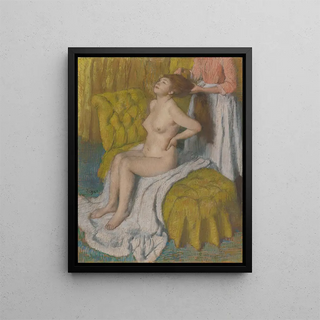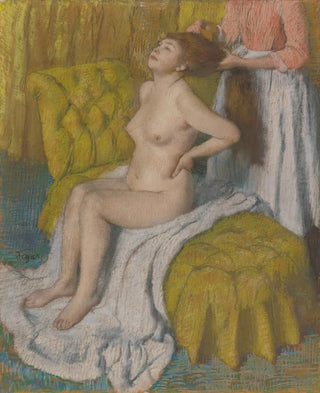Art print | Woman having her hair combed - Edgar Degas


View from behind

Frame (optional)
In the fascinating world of art, some works manage to transcend time and capture the very essence of everyday life. "Woman getting her hair combed" by Edgar Degas is one of these iconic pieces. Created at the end of the 19th century, this artwork evokes a delicate intimacy and a fleeting moment in a woman's life. The painting, with its simple yet evocative subject, invites us to contemplate not only the gesture of grooming but also the beauty of femininity and the poetry of daily gestures. In this intimate scene, Degas transports us to a universe where time seems suspended, offering a glimpse of a reality that is both mundane and sublime.
Style and uniqueness of the work
The uniqueness of "Woman getting her hair combed" lies in the technical mastery and originality of the treatment of forms. Degas, renowned for his innovative approach, plays with light and shadow to create an intimate atmosphere. The composition, centered on the female figure, is characterized by soft lines and delicate colors that evoke serenity. The choice of subject, a woman absorbed in a moment of personal care, reflects the artist's interest in daily life and genre scenes. The posture of the woman, slightly bent, and the attention given to her hair highlight the grace and vulnerability of her character. Furthermore, Degas uses daring angles, often inspired by photography, to add a dynamic dimension to the work, thus breaking away from the academic conventions of his time.
The artist and his influence
Edgar Degas, an emblematic figure of the Impressionist movement, left his mark on his era with his unique perspective on society and urban life. Born in Paris in 1834, he was influenced by the artistic movements of his time while developing a personal style that was entirely his own. His passion for ballet and scenes of Parisian life led him to explore various themes, ranging from dancers to women in their intimacy. Degas is often considered a precursor of modernity, having mastered capturing

Matte finish

View from behind

Frame (optional)
In the fascinating world of art, some works manage to transcend time and capture the very essence of everyday life. "Woman getting her hair combed" by Edgar Degas is one of these iconic pieces. Created at the end of the 19th century, this artwork evokes a delicate intimacy and a fleeting moment in a woman's life. The painting, with its simple yet evocative subject, invites us to contemplate not only the gesture of grooming but also the beauty of femininity and the poetry of daily gestures. In this intimate scene, Degas transports us to a universe where time seems suspended, offering a glimpse of a reality that is both mundane and sublime.
Style and uniqueness of the work
The uniqueness of "Woman getting her hair combed" lies in the technical mastery and originality of the treatment of forms. Degas, renowned for his innovative approach, plays with light and shadow to create an intimate atmosphere. The composition, centered on the female figure, is characterized by soft lines and delicate colors that evoke serenity. The choice of subject, a woman absorbed in a moment of personal care, reflects the artist's interest in daily life and genre scenes. The posture of the woman, slightly bent, and the attention given to her hair highlight the grace and vulnerability of her character. Furthermore, Degas uses daring angles, often inspired by photography, to add a dynamic dimension to the work, thus breaking away from the academic conventions of his time.
The artist and his influence
Edgar Degas, an emblematic figure of the Impressionist movement, left his mark on his era with his unique perspective on society and urban life. Born in Paris in 1834, he was influenced by the artistic movements of his time while developing a personal style that was entirely his own. His passion for ballet and scenes of Parisian life led him to explore various themes, ranging from dancers to women in their intimacy. Degas is often considered a precursor of modernity, having mastered capturing






